
SWEET ON SWEETCORN, PUMPED ABOUT PUMPKINS ~ PG.


SWEET ON SWEETCORN, PUMPED ABOUT PUMPKINS ~ PG.



Q: When and how often should I be getting a mammogram?
In line with the U.S. Preventive Services Task Force, Bronson recommends beginning annual mammograms at age 40. Some people may be at an increased risk of breast cancer due to family history or a positive gene test. Different guidelines, including earlier screening and additional tests, are recommended for this high-risk population. By age 25, you should know your risk. If you are wondering if it is time to start screenings, talk with your primary care or OB/GYN provider.
Healthcare bronsonhealth.com/mammogram (269)

Justin Reynolds Manager
Q: I hear that Sherriff Goslin Roofing uses their own unique shingle. Can you tell me more about this shingle?
A: The Art Loc shingle is SherriffGoslin’s original patented shingle. It can be used as a re-roofing shingle over another layer of existing shingles, or as a primary shingle over roof sheathing. It assures a smooth, windproof and watertight job. The Art Loc shingle provides a unique appearance and lends character with distinction to any home.
Today’s Art Loc shingle has been modified to include an ingredient known as an SBS (Styrene-ButadieneStyrene) polymer, which is used to alter the properties of asphalt, making the asphalt tougher and more flexible. This polymer dramatically slows down the aging process of the asphalt, providing superior waterproofing, low temperature flexibility, impact resistance, high wind endurance and extended life expectancy.
Call us at (269) 342-0153 or visit us at worryfreeroof. com today to learn more.
Sherriff-Goslin Roofing Co.
Since 1906
342-0153
800-950-1906
Member Home Builders Association of Greater Kalamazoo

Chuck Henrich President & Owner
A: Medicare starts for most adults at age 65. If you elected to take your Social Security prior to turning 65, you will be automatically enrolled in Medicare Part A and Part B when you turn 65. If you are NOT taking Social Security, you can apply online at SSA.gov.
You need to create your secure my Social Security account to sign up for Medicare. After you sign up, you’ll get a welcome package with your Medicare card, which has your Medicare Number. You’ll need your Medicare Number to create your Medicare Account on Medicare.gov to join a plan or buy supplemental insurance.
To better understand your Medicare options, please feel free to teach out to our office.
The Atriums • 4341 S. Westnedge #1201 269-323-7964

A: Located on the second floor above Sawall Health Foods , Café 36 uses natural and organic ingredients in preparing flavorful and exotic selections like Blackened Salmon with Blistered Tomato Rice, Asparagus, and Bleu Crea and Pork Secreto with Chimichurri rice, grilled fennel and charred lemon! There are wonderful pasta dishes including: Bolognese, Cavatelli and creative pizzas such as the Bambini, Margherita, Crudo and Vegano. Organic salads, with produce from local farmers, include Kale Caesar and Spinach & Arugula. There are 20 wines, organic craft beers and hand-crafted cocktails that compliment any meal. After dinner, delicious desserts include Amorino Gelato and Sorbetto, Eton Mess -- English whipped double cream, house-made Meringue, red berry Chambord coulis, Amorino Gelato, and Seasonal New York Cheesecake. Café 36 is very popular with Sawall customers looking for a healthy place to eat. Check out the new fall Café 36 menu!
Café ’36
Wed—Sat 5-9pm 501-3399
Sawall Health Foods
Oakwood Plaza • 2965 Oakland Dr. at Whites Rd. • 343-3619 • www.sawallhf.com


Diana Duncan Director of Sales and Marketing
Q: What is the timeframe for move-in for an independent living apartment or cottage in a senior community?
A: A move to a community may include a visit to your physician, a medical interview from a qualified health professional, financial qualification and proof of assets, as well as the renovations or building of your new home. This process may take 30 days to a year or more depending on your specific circumstance.
Friendship Village
“Where Connections Matter” 1400 North Drake, Kalamazoo 269-381-0560 www.friendshipvillagemi.com

Kim Powers, Owner, Licensed Professional Counselor
Q: What should I do to lift the weight of my hidden addiction?
A: It is a brave choice to admit you have developed behavior that has become a stronghold. The next step is to choose a safe space, person, or professional to learn skills to overcome and manage the behaviors and hold yourself accountable to your goals. You can find the victory, strength, and encouragement to overcome! There is freedom in the light.
In August, Jackie and I took a trip to the U.K. This was my first trip to Europe and I hope to do it again soon.
In preparing for the trip, we went to the bank and exchanged a few hundred dollars for Euros and tried to understand the exchange rate and bank fees.
We landed in London and immediately found that they do not use the Euro but the British Pound which we had none of.
We were trying to board the underground train system (The Tube) at Heathrow Airport to take us about 15 miles up near Big Ben and our hotel. We did not have a clue what to do or how to pay until a lady explained which train we needed and the ticket taker at the turnstile said to just scan our debit card when entering and scan it when exiting. We did it and it worked but had no idea as to the cost until it showed top a few week later on a bank statement.
Jackie and I quickly found that we could scan our debit card anywhere and cash was never needed
Later on, we found that scanning our debit card resulted in dozens of small 17 and 31 cent foreign exchange charges on our bank statements but it was still the best way to pay.
Arriving in Northern Ireland, we still had no luck using the Euro. We almost forgot we even had them until arriving in Dublin (a separate country) and finding that they did accept them. Jackie quickly started paying for everything in cash, getting back lots of odd looking coins to give to her grandsons.
Other than the additional complications of foreign currency and exchange rates in Europe, it isn’t much easier in the U.S. with paying and receiving money online with PayPal, Apple Pay, Venmo, etc.
These newer forms of paying also complicates buying airline, sports and concert tickets whereby you pay online and receive an electronic ticket. Not too complicated until you try to find them later on your phone.
I used to write a half dozen or more checks per month for utilities, etc., but now almost all monthly payments are automatic deductions out of my bank account
Cash is used less and less and some businesses no
longer accept cash.
When I was growing up, we paid cash for everything.
If I was lucky, I had a few coins in my pocket for a 5 cent pack of baseball cards or 12 cent comic book.
We received 10 cents for doing the dishes and 50 cents for mowing the lawn.
“A penny saved is a penny earned,” is a famous Ben Franklin quote. Now, “A penny saved..” is tossed in a large jar with other loose change.
There are probably millions of dollars worth of loose change in jars on nightstands across the country
The mint’s 2022 annual report revealed that it costs 2.72 cents to make 1 penny and 10.41 cents to make a nickel. In comparison, coins like dimes, quarters and the half-dollar cost less to produce and distribute than their face value
We once had a machine at the Kalamazoo Gazette where we could bring in a bag of change and have it counted and given paper money back. The lady who ran it was not always the friendliest and loved handing me back my currency along with a baggie with an assortment of guitar picks, paper clips and buttons that she claimed clogged up the machine.
Times certainly have changed and I cannot image what my grandfather or father would think of these new fangled ideas.
Steve Ellis, SPARK Publisher steve@swmspark.com





Let them tell you a story
Lee A. Dean screendoor @ sbcglobal.net
I have been a constant reader since the age of 5. In all that time, my preferred method of engaging with the printed word has been with physical media. The weight of a book, the rustle of newspaper pages, the glossy feel of a magazine — these are a unique mixture of intellectual and sensory pleasures.
My preference still holds, but now I am fully immersed in another way to take in information: letting someone else read from a book to teach me something or tell me a story. This transition is due largely to the fact that my eyes are no longer able to easily navigate small print, particularly on yellowing pages.
This is not a completely new preference. My enjoyment of listening to others read began in fourth grade, thanks to my teacher, Mrs. Pearson.
As a younger kid, I occasionally enjoyed listening to people read aloud, especially my Grandma Dean, But Mrs. Pearson upped the ante. Starting with the first day of school in September and ending on the final day in June, she read the Laura Ingalls Wilder “Little House” books to start each day.
I’m not sure whether this practice would resonate with today’s fourth graders, who live in a digital and image-dominant world, but the stories were jet fuel for my imagination. Mrs. Pearson read “The Long Winter” to us in a warm classroom while the usual harsh Bloomingdale winter was battering us outside. As the winter subsided and spring arrived, we heard “Those Happy Golden Years.” My mood brightened along with the climate. In high school and college, I participated in forensics competitions that included the categories of storytelling, dramatic interpretation, and humorous interpretation. As the reader/storyteller, you get to add color to each story through different voice characterizations and inflection points. Participating in reader’s theater at Western Michigan University was also enormous fun.
Humorous interpretation was my specialty. My go-to selection was “The Two-Wheeled ATV” by outdoor humorist Patrick McManus. The story is his reminiscence of riding a malevolently malfunctioning bicycle. I was asked to read this piece at a student assembly. I knew my fellow students would be somewhat blasé until I got to the part where the bike chain snapped and flung the rider like a javelin into a pile of manure. I knew that would make ’em pop,
and it did.
My current obsession is an audiobook subscriptio0n service called Audible. Audible isn’t perfect — you can’t see the illustrations or consult footnotes. A few titles are read by AI (artificial intelligence) voices, which can result in unintentional comedy when the “narrator” incorrectly renders the accent of a particular word. In a recent book on how to write for online sources, I heard the narration confuse CON-tent with con-TENT, which did not make me feel content. Otherwise, I have richly relished hearing the art of storytelling performed by gifted narrators, such as Simon Callow’s performance in “A Tale of Two Cities.”
If you’re economically challenged and can’t afford Audible, not to worry. With one of the most valuable items anyone can own, a library card, you can access thousands of electronic and audio titles. If you have a computer or smartphone, you can access podcasts such as “StoryCorps” and “This American Life,” two prime examples of the storytelling genre.
Hearing a tale spun on an electronic device is great, but my favorite storytelling setting is still in person. Storytelling is an extremely effective icebreaker. The best way to get to know someone is to ask a version of “tell me about a time
when….” We all have interesting stories to tell about ourselves and each other. We’ll never run out of material. After 38 years of friendship
As we get older, the value of the stories we tell seems to increase. We all can identify the people who tell us the same story for the 50th time. The exchange usually goes like this: “Did I ever tell you about the time I told the time I tried to ride an ostrich?” We reply, “yes,” in the hope that we won’t hear the story for the 51st time. This never works, and that’s just fine. If the story is good enough, most people enjoy hearing it again and again. There’s another key reason we indulge the storyteller: we hope someone will tell a great story and we’ll say, “Really? I’ve never heard that one before!” , I’m still learning new things about my wife, the Viking Goddess, often through a story.
I have no doubt that stories are the reason you are kind enough to keep returning to this space. I can’t imagine anyone turning to Page 4 each month eagerly anticipating my opinions on Peruvian foreign policy or whether Spencer Torkelson will ever consistently hit a slider.
No, you came for a story, and I’m glad to oblige. In person, I always to try to never tell a story more than once, but you’re welcome to read everything in Spark as many times as you like.



By Laura Kurella
Even though I have zero German blood running through my veins, I have always had a certain affection for Oktoberfest, especially since good food and drink seems to be at the center of its celebration.
According to some internet research, Oktoberfest didn’t start out as the fest it is today. In fact, the fest’s inspiration came by way of marriage. A special marriage that took place on October 12, 1810, between Crown Prince Ludwig (who later
became King Ludwig I), and Princess Teresa of Sassonia-Hildburghausen.
All the citizens of Munich were invited to join in celebrating their special union, which turned this royal event into a veritable feast for all of Bavaria.
The day was so enjoyed by all, most especially the horse races it included, that the following year a decision was made to repeat the horse races, which ushered in what would become the start of the now Oktoberfest tradition!
Dating back to 1313, bratwurst was first made in the Franconian city of Nuremberg, which is still considered an internationally renowned

center for the production of grilled sausages to this day.
Derived from old, High German with “Brat,” meaning finely chopped meat and “wurst,” meaning sausage, today many now associate the name to refer to the German verb, “braten,” which means to pan fry or roast.
Germans did bring their sausage to America and helped it become popular during the 1920’s in Sheboygan County, Wisconsin. which is known for its large German population. It was there, in Wisconsin, that poaching brats in beer was the best
way to cook them, too.
Poaching a sausage in beer, with butter and onions, prior to grilling over charcoal, not only imparts additional moisture and flavor, but also helps to cook out excess fat, which greatly reduces grease fires and uneven cooking that can occur on a grill.
Today, brats are available from sea to shining sea, giving us many opportunities to shop for them, and just like anything else, always best when bought from small, local meat markets that hand-make them in small batches using quality ingredients.
Prep time: 10 minutes; Cook time: 30 minutes; Total time: 40 minutes. Yield: 4 servings
4 sweet or red (or mixed) onions, peeled and cut into small wedges
1 tablespoon favorite cooking fat/oil
1-ounce red wine vinegar
1-ounce pure maple syrup
1 cup cherries (any style/variety/ blend) pitted + halved
8 regular (or cherry) brats
1 fresh-ground black pepper, or to taste
1 teaspoon (or more) fresh thyme leaves
1 teaspoon (or more) freshly minced rosemary
Preheat the grill (or grill pan) to 400 degrees.
Once onions develop caramelization, add vinegar and maple syrup, then scrape the bottom of the pan to loosen any bits. Reduce heat to low, add the cherries and the spices, to taste. Cover and let them coast as you grill brats. Once the grilling surface has reached the desired temperature, place brats on the grill and cook, turning, until they begin to crack, about 7 minutes. As brats finish grilling, move them to cherry sauce in the cast iron skillet. Once all brats are in the skillet, cook for 5 more minutes then remove from heat and allow the pan to rest, covered for 5 minutes before serving.






In 1923, a scandal rocked the small English seaside town of Littlehampton when residents suddenly began receiving vulgar letters from an anonymous sender. Wicked Little Letters is a mostly true but entirely enjoyable adaptation of this story from director Thea Sharrock. Olivia Colman (The Favourite, The Crown) is Edith Swan, a godfearing spinster living with her aging parents and Jessie Buckley (Women Talking, Fargo Season 4) co-stars as Rose Gooding, an Irish immigrant and single mother who lives next door. The two have a bit of a tempestuous relationship on account of some meddling on behalf of Edith’s overbearing father (Timothy Spall), and when Edith begins to receive frequent letters penned in an obscene and distinctly absurd vernacular, Rose swiftly becomes the primary suspect. The local constabulary are all too keen to close the book on this case, but Gladys Moss (Anjana Vasan), West Sussex’s first female police officer suspects there may be more to this tale of ribald letter-writing than meets the eye. A charming whodunnit in which Colman and Buckley absolutely shine, Wicked Little Letters is an awful lot of fun. –
Submitted by. Patrick J.

The artist Anselm Kiefer, one of Europe’s major artists to have emerged after World War II, receives a deserving biographical portrait by celebrated German director Wim Wenders. The German painter and sculptor’s works have been called ‘monumental’ for both
weightiness. Kiefer’s ambitious wrestling with the legacy of German culture and politics in the wake of the horrors of WWII resides at the heart of his artistic vision and practice. In addition to biographical and career details regarding Kiefer’s life, Wender’s evocatively shot documentary immerses the viewer within Kiefer’s strikingly rendered work, a mix of the visceral and lyrical, the transcendent and the industrial. –Submitted by. Ryan G.

It’s a slight peeve of mine to see movie sequels get numbers slapped on the end of the original release’s title. Thankfully, this is my only issue with 2024’s Pixar smash Inside Out 2, a gripping and perceptive follow-up to its 2015 predecessor. (Pixar has had great popular and critical success with numbered sequels for its Toy Story franchise; its series of Cars films, not so much.) It’s been two years since Riley Andersen, now 13, moved with her family to San Francisco. The emotions which guided her during her previous cinematic journey – Joy, Sadness, Fear, Disgust, and Anger – have stayed with her, forming her sense of self. When puberty hits just ahead of a weekend ice hockey camp outing, new emotions - Anxiety, Envy, Embarrassment, and Ennui – join the older emotions, creating chaos, altering her self-awareness, and threatening to derail her friendships. If I had my way, I might have named this movie Insides Out, but that would have been too on the nose. Knowing Riley will experience more new emotions as she ages, I’ll hope the Inside Out series will see its numbers grow. –
Submitted by. Patrick J.
“If you have the opportunity to do good–do it” – Ann Frazier
By Jim Coppinger, Milestone Senior Services Volunteer
Ann Frazier’s lifelong dedication to volunteering began at the age of thirteen in growing up in South Haven, Michigan, helping elderly neighbors with errands and meals. She says she was inspired by her parents, especially her mother, who raised ten children with an unwavering focus on responsibility and care for others.
Ann formally began volunteering in 1999 when she joined the Van Buren County Senior Services Area Agency’s Family Friend Program as a “friend” and mentor to a six-year-old girl with severe scoliosis.
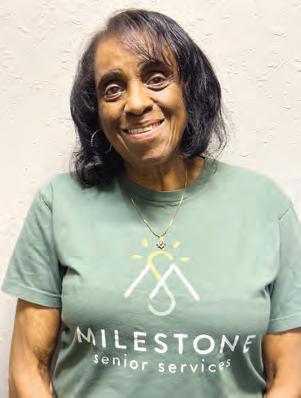
For seven years, Ann ongoing support to help that child overcome daily obstacles. She also provided transportation to medical appointments, enrichment outings, and assisted in securing vital equipment such as wheelchairs and walkers for her. Ann proudly shares that very special girl later graduated high school with honors. Recently, Ann had a heartwarming reunion with her which underscored the lasting impact their relationship had on both of them. Nothing could be more fulfilling and rewarding.
The next seven years, up until the COVID pandemic, Ann worked with seniors at MediLodge, a nursing care facility in Kalamazoo. As the pandemic subsided, she returned to volunteering through Milestone’s Senior Companion Program, now partnered with four seniors. Additionally, Ann has been involved in the Grandparents Raising Grandchildren Program, where she mentored children.
Ann, a mother of six, is now a grandmother to eleven and a great-grandmother to seven. She often brings her grandchildren along on her visits to seniors, noting how much joy children bring to older adults. She was a professional upholster for thirty years and still does some upholstery work.
Years ago, Ann founded “Teens United,” a program offering young people alternatives to street life. The program taught these teens to bake, hold bake sales to raise money for events, and take trips. Ann delights in sharing how these nowgrown adults frequently share fond memories with her when they bump into one another. She also organized a women’s senior softball team in South Haven, called the Surefires, for five years.
Ann credits her fulfilling life to helping others, saying, “My life has been so rewarding; helping others keeps me strong. I’m in my eighties and have no pains, and take no pills.” She emphasizes the support she receives from those around her, adding, “There is always someone there to help me help others. if you have the opportunity to do good…do it.”
Beyond volunteering, Ann enjoys spending time with her family, gardening—especially growing vegetables–canning, cooking, and baking. A longtime hobby she enjoys is photography. Recently, Ann has been inspired to photograph trees during her daily “God walks,” finding these images a source of reflection, meditation, and spiritual fulfillment.
Ann’s life is a testament to the power of kindness and compassion, inspiring everyone around her.
Milestone Senior Services (previously known as Senior Services of Southwest Michigan) is an AmeriCorps Seniors grantee. AmeriCorps Seniors empowers people age 55 and older to serve their communities. RSVP helps people find a volunteer opportunity that fits their passion. There are currently opportunities in Kalamazoo County and a few in Calhoun County. Volunteers are needed with Meals on Wheels, Kalamazoo Loaves & Fishes, Telephone Reassurance for Seniors, Milestone Home Repair, and more. Regular, flexible schedules available. Contact RSVP at 269-382-0515 or apply to volunteer at www.milestoneseniorservices.org.


By Dave Person david.r.person@gmail.com
If you’re sweet on sweetcorn and get pumped about pumpkins, Mick Kokx is the person to see.
Kokx, who operates Kokx’s Produce across M-43 from the Gilmore Car Museum in Hickory Corners, concluded another successful sweetcorn season in August and is now featuring his pumpkins — both ornamental and carving varieties — and winter squash at his self-service produce stand.
He also sells his produce at an Amish auction near Dowling, where he buys other produce to sell at his stand.
With ample rain early during the growing season, Kokx says his 14-plus acres of sweetcorn produced a steady supply of corn for nearly six weeks, and he expects the pumpkin and winter squash harvest will be just as successful.
The pumpkins and squash will be available at his roadside stand daily through October.
“The pumpkin crop, it looks to me, is going to be as good as the sweetcorn crop,” he said as he surveyed some of his more than three acres of pumpkins and winter squash in early September. “We’ll sell a couple thousand, I hope.”
The pumpkins come in all sizes with some having topped out at 50 or 60 pounds over the years, he says.
Kokx, 75, grows his sweetcorn and pumpkins on the nine acres he owns at 14566 South M-43 and a nearby 40 acres that he leases.
Many of his regular customers come from nearby Gull Lake, he says.

In addition to selling his pumpkins at his produce stand and at the Amish auction, he takes them to four area grocery stores for sale.
Until three years ago, Kokx says, he grew all his own produce,



but since then he has limited his crops to sweetcorn, pumpkins and winter squash, relying on the Amish auc tion for everything else.
With 12 grandchildren and four step-grandchildren living in the area, Kokx and his wife, Sharon, have had plenty of help harvesting the crops over the years, but many of those grandchildren have reached adulthood and now have other means of livelihood.
“They all moved on and got good jobs,” he says.
Still, this year he has had four grandchildren and four other area youths on his payroll picking and selling first the corn and then the pumpkins.
In addition to growing produce, Kokx has a mare, two ponies, six goats, 40 lambs — he sells the goats and lambs for meat — and his faithful border collie, Jax, who, like Kokx, prefers sweetcorn to squash. Jax even picks his own ears, husks them and eats them raw. Kokx says he has the typical wildlife intruders such
them, including using a cannon to scare away the birds before they can devastate his corn crop.
Farming is in Kokx’s blood, starting “from the time I could walk” on his family farm in Fremont.
He might have stayed there and continued in the family business if it hadn’t been for the disastrous outbreak of PBB contamination in cattle feed in Michigan 50 years ago that wiped out the family’s livestock and their livelihood.
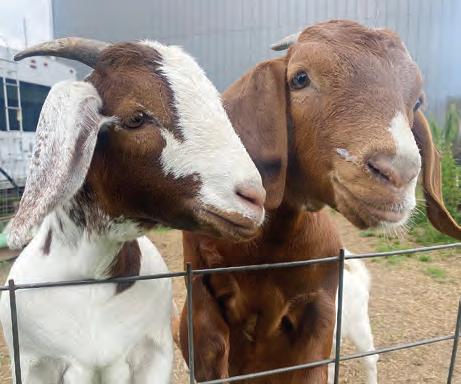
“That’s why I’m down here,” he says. Actually, it was a circuitous route that brought him to Hickory Corners.
He first went to work for a horse breeder in Pennsylvania, then took a job at the Michigan State University Upper Peninsula Research and Extension Center in Chatham.
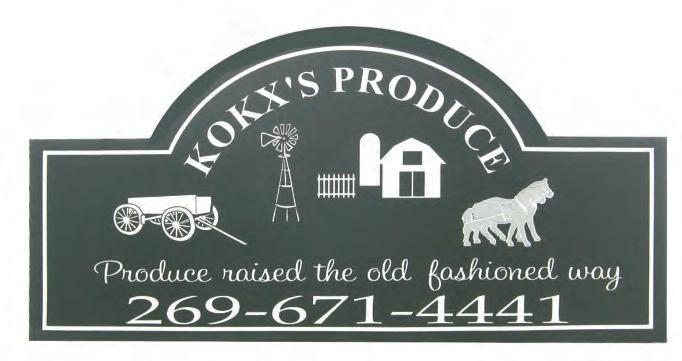

In the early ‘90s he transferred to MSU’s W.K. Kellogg Farm in Hickory Corners where he helped grow feed crops for the farm’s cattle, then at the end of the day returned home to work his own fields, for the first 15 years opting to use draft horses rather than a tractor.
He retired from the Kellogg Farm 16 years ago.
In recent years, the Kokxs take their fifth wheel recreational vehicle to Texas for several weeks during the winter, but they always make sure they are home for planting season.
“As long as I enjoy what I’m doing, not going to quit,” Kokx says.





By Tom Springer, Vice President of Development, Kalamazoo Nature Center
Each bottle of pale gold honey on sale at the Kalamazoo Nature Center’s Trails End giftshop has a history. And it begins and ends with this fraction: 1/12. Or more precisely, 1/12th of a teaspoon.
That’s how much honey a single worker bee will produce in her six to eight-week lifetime. To produce a 1 lb. jar of honey requires the life’s work of 1,100 bees. Remember them thankfully as you squeeze their bounty onto toast or into tea. Or my favorite, a honey and peanut butter sandwich on whole grain bread. It makes a fine work lunch along with celery sticks, a big handful of
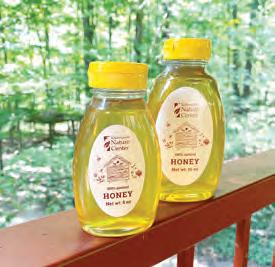
barbecued kettle chips and a local Michigan apple. It’s well worth a few sticky crumbs on the home row keys of your computer.
As for KNC’s honey, it could hardly be more local. It comes from three hives kept at DeLano Farms, about ½ mile from the Visitor Center as the bee flies. Volunteers from the Kalamazoo Bee Club installed the hives in spring and harvested 30 gallons of honey in August. If you’re still counting, that’s the work of roughly 34,500 bees. Since female bees do all the field work, it’s fair to ask what exactly the males do. For the most part, not much. They recline inside the hive, where they eat more than their share, and fly only once to fertilize the queen in mid-air. The drones then fall lifeless to earth, their service to the femme fatale queen complete.
If ever a place was well-suited to bees, it’s DeLano Farms. It houses a Community Supported Agriculture (CSA) program that raises 20+ varieties of vegetables, herbs and cut flowers for 90 subscribing families. The tidy, two-acre farm features a

color wheel array of vibrant greens and leaf textures. Although for bees, the biggest draw is the 50x12-foot beds of flowering perennials, a veritable pollinator smorgasbord.
“The beds have two kinds of vervain, two kinds of bee balm, echinacea, aster, mullein, veronicas and a boring, nondescript plant called figwort that bees absolutely love,” says Kirsten Clemente, DeLano Farms director. “We’ve also got medicinal and edible plants in the beds -- elderberries, gooseberries and peach trees. We have tea garden roses that smell lovely. I plant them
for a volunteer who uses their rose hips.”
This botanical menagerie attracts pollinators of all stripes and embodies DeLano’s “regenerative” approach to agriculture. With regenerative farming, you enrich the soil with organic matter and let that stimulate plant growth instead of synthetic fertilizer. And the lush beds, Clemente says, attract a “plethora of pollinators” that give plants the reproductive boost they need to fill all those weekly CSA orders.
Given all the native pollinators, the honeybees – a Eurasian import -- may not be necessary. Yet as little furry brown and gold livestock, their annual yield bears the farm’s “terroir” as no other sweetener can. There’s a limited supply in the Trails End gift shop, so get yours before fellow foragers beat you to it.
Tom Springer is vice president of development at the Kalamazoo Nature Center and author of Looking for Hickories and The Star in the Sycamore.






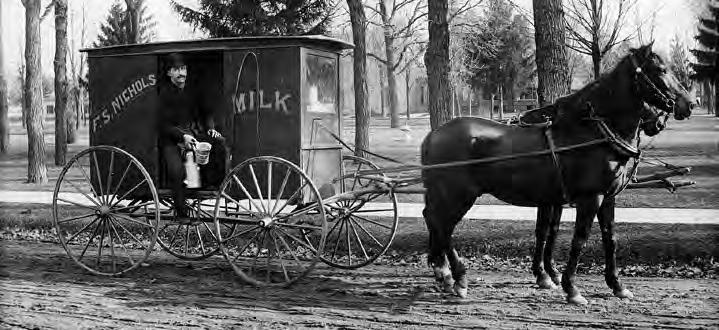
by Keith Howard, Kalamazoo Public Library
Got milk? During the 1840s, two brothers from New England established one of Kalamazoo’s earliest commercial dairy farms. The family business was carried on over three generations and their home became a West Main Street landmark.
Sabin M. Nichols and his older brother Ezra arrived in Kalamazoo from Vermont in the fall of 1843 and bought Fletcher Ransom’s 160-acre farm in Section 18 of Kalamazoo Township. Their property was on the north side of West Main Road in what is now the Westwood Neighborhood, with the eastern border along an old farm lane that became Nichols Road.
For the first few years the two families shared a farmhouse that stood near the northwest corner of West Main and Nichols, but the brothers soon split the property. Sabin and his wife Sarah took the southern portion with the existing home, while Ezra and his wife Lucy took the northern half. By 1848, Ezra had built a lovely Greek Revival brick cottage, which still stands along the west side of Nichols Road. On what was described as “one of the many beautiful farms of Kalamazoo,” the brothers raised sheep, hogs, and dairy cattle; grew wheat, potatoes, corn, barley, and oats; and made sweet cream butter. Sabin Nichols was said to be the first person to sell milk in Kalamazoo. By 1860 Ezra had sold his Nichols Road farm and moved to Gull Road. Sabin and Sarah continued

farming on West Main while raising their two sons, Charles H. Nichols, and his kid brother Frederick. But life on the farm during the 1860s was not easy. Charles Nichols died in 1865 at the age of twelve, while Frederick learned the meaning of hard work at an early age.
Frederick Sabin Nichols (born in 1858) attended Alamo Avenue school and in 1877 he graduated from Kalamazoo high school. Nichols built a 14-room home on the property in 1884, which eventually replaced the older structure. A year later he married Miss Jennie Goodridge, who had grown up on a farm at the Drake Road corners, just a mile west of the Nichols place. The couple would raise two sons, Allen and Charles, and a daughter, Ruth.
After Sabin Nichols’ death in 1889, Frederick took over his father’s dairy farm and became actively involved in local business and politics. He was a Kalamazoo Creamery Company stockholder for a time, served as township treasurer, township supervisor, a supervisor for the Kalamazoo County Republican Caucus, and a Kalamazoo school inspector.
Frederick and Jennie Nichols spent their entire lives as dairy farmers. Jennie Nichols passed away in 1939 at the age of 74, Frederick died in 1942 at the age of 84 while still farming with his son Allen. Allen Merrel Nichols (born 1887) was the third generation to carry on the family dairy business until his own retirement in 1958. The land was then sold, and the 76-year-old home was torn down to make way for future development. The Landing apartment buildings now occupy the property.

Amelia Hansen, Media Specialist, Southwest Michigan Land Conservancy
Some people may think southwest Michigan is just a place to “fly over” between Chicago and Detroit, but they’re missing out! We live in one of the prettiest and most naturally diverse parts of the country - and are lucky that so many people care about keeping it that way. Our region is home to many conservation groups - from grassroots collectives to non-profit organizations to small government offices - that are focused on keeping local land and water healthy.
Southwest Michigan Land Conservancy (SWMLC) is one of them: we protect nature in Allegan, Barry, Berrien, Branch, Calhoun, Cass, Kalamazoo, St. Joseph, and Van Buren Counties. SWMLC is a local, accredited non-profit land trust that works with people in the community to restore habitat, protect water quality, support biodiversity, strengthen our region’s climate resiliency, connect people with nature, and help families conserve the land they love.
We were founded in Portage in 1991 by local folks worried that some of the region’s best natural areas were being
lost to development. Since then, we’ve grown to a staff of ten and have protected more than 19,000 acres of forests, wetlands, savannas, waterways, and

farms. We own 38 refuge preserves that provide wildlife with good places to find food, shelter, and raise young. We’ve partnered with others to create public natural areas that we don’t own but will legally protect forever. And we have 18


public preserves that are open every day from dawn to dusk, with no admission fee, so that everyone has a natural place to walk, explore the seasons, spend time with their kids, and let nature’s peace seep into their soul.
SWMLC is very grateful to have a smart, energetic, generous bunch of volunteers to help us with our work. We rely on their invaluable contributions and wish we had even more of them! Maybe these weekly volunteer-driven stewardship workdays would be a good fit for you . . . are you concerned about the environment? Have a few hours to spare for a meaningful cause? Do you like working outdoors? No special tools, strengths, or skills needed and there’s no commitment - come when you can or feel like it, you will always be welcome!


By Richard Martinovich
“Café 36” opened July 2017 -- “36” a nod to the year 1936 Frank Sawall founded his health food store in Michigan. Located on the second floor above Sawall Health Foods on Oakland Drive, Café 36 uses natural and organic ingredients in preparing flavorful, exotic, and exciting selections like Blackened Salmon with Blistered Tomato Rice, Asparagus, and Bleu Cream… and Pork Secreto with Chimichurri rice, grilled fennel and charred lemon! There are wonderful pasta dishes; Bolognese, Cavatelli, creative pizzas such as the Bambini -- uncured pepperoni, Italian sausage, hardwood-smoked bacon; Margherita Crudo, fresh basil, uncured prosciutto; Vegano, vegan cheese, artichoke, mushrooms, vegan Italian sausage. Organic salads, with produce from local farmers, include
Kale Caesar and Spinach & Arugula.
There are 20 wines, organic craft beers and hand-crafted cocktails that compliment any meal.
After dinner, delicious desserts await: Amorino Gelato and Sorbetto, Eton Mess -- English whipped double cream, house-made Meringue, red berry Chambord coulis, Amorino Gelato, and Seasonal New York Cheesecake.
In 1826, French author Jean Anthelme BrillatSavarin wrote, “Tell what you
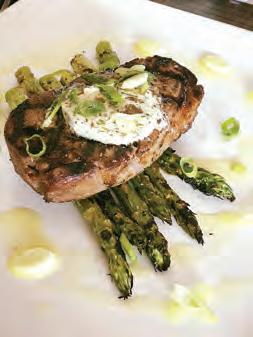
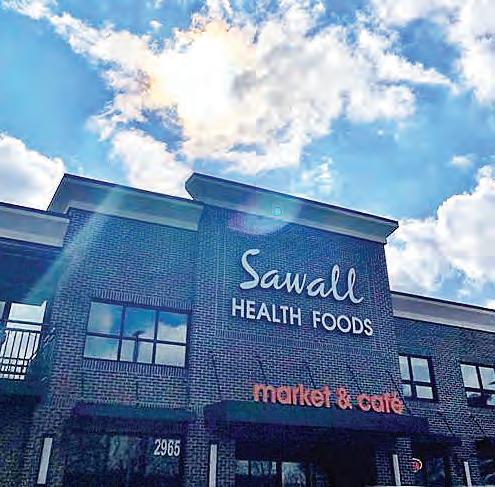
eat, and I will tell you what you are.” “You are what you eat” has even more significance today as consumers are aware of the adverse health effects of preservatives, dyes, and artificial ingredients in
food. Frank Sawall was a biochemist who in the 1930’s warned of the dangers of pesticides. As the oldest health food store in the US, Sawall Health Foods has been a pioneer in advancing healthy options with natural and organic products, vitamins and supplements. For generations, Kalamazoo residents have recognized Sawall Health Foods as their go-to place for optimal health. Café 36 is popular with Sawall customers looking for a healthy place to eat. The Café 36 motto is “Eat Smart. Live Long.”
Café 36 extra menu portions, such as Char-Grilled Hanger Steak, Blackened Salmon and Beef Short Ribs are cooked at the end of the week and available in the Sawall deli.
Check out the new fall Café 36 menu!
2965 Oakland Drive • Wednesday-Saturday 5-9 pm • 501-3399


By Steve Ellis
In last month’s issue, I chronicled my road trip through Marcellus, Dowagiac and Niles. Here is the remainder of the trip through Berrien Springs, Cassopolis, Vandalia and Jones.
Berrien Springs is about an hour from Kalamazoo and was platted in 1831. The Berrien Springs courthouse was completed in 1839, making it the oldest courthouse in the state and is now a museum. Muhammad Ali once had a house here. Berrien Springs was once known as the Christmas Pickle capital of the world, and after a short hiatus, has revived their annual Pickle Festival on July 4th.
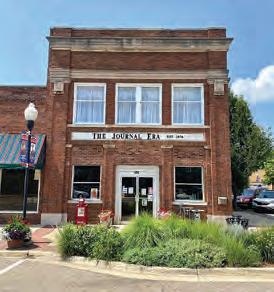
I stopped and talked to Kathleen Pullano, the long-time publisher of the Journal Era, the local newspaper. The paper began in 1874 and the office is chocked full of Berrien Springs memorabilia. When I asked her what things she would suggest I see in the area, she mentioned the remains of the old St Joseph Valley Interurban train line bridge across
Lake Chapin. This line, built between 1889-1897, once connected Berrien Springs to Buchanan and Northern Indiana. There are plans to build a 1,300 foot walking bridge

across the lake, using the old cement abutments. After standing on a bluff up above the lake, I tried to imagine the bridge and hope to see its completion.
My next stop was about 20 miles to the east in Cassopolis. Cassopolis was platted in 1831 and incorporated as a village in 1861. The town was a major part of the Underground Railroad and many African Americans settled here. This was my first trip through the area in a few years and was impressed with the refurbished downtown. At the southern end of Broadway Street, the main north-south road through downtown is a completely restored 1950’s Sinclair gas station. Just past it, is the popular Stone Lake Beach


with a long pier, paddle boats and a very large, sandy beach. It was packed with swimmers on the hot day I was in town. I enjoyed a delicious ice cream cone from Twirl as I walked the pier.

Broadway Street is lined with classic two and three story, brick buildings. I met a man who was an artist and blacksmith. His shop was packed with cool antiques. I also met Evonne Gaskin, a friendly life-long resident, who has a Gemstone, Fossil and Mineral Specimen store. She also enjoys attending fair and farmers markets, selling succulents and cacti. Her dad is the local barber.

I poked my head into the door of the Cassopolis Beer Company and
asked about the large crowd that had gathered there on this weekday afternoon. I was told that it was their first day (and first hour) of the new brewery opening. The owners were very friendly and told me about all of their hard work that went into turning the old fire station into a brewery. It was impressive and well worth a return visit.

Stone Lake Bar and Grill, Broadway Cafe, The B & C and the Holden Green Tavern are popular food destinations.
I headed back east to Kalamazoo along M60, passing through the small town of Vandalia, another major Underground Railroad stop. The Bonine House, a gorgeous red brick home, is being restored by the Underground Railroad Society of Cass County.

My last stop was in Jones. The small town has an interesting history of being turned into a Wild West tourist attraction back in the 1970’s by Ed Lowe, inventor of Kitty Litter. I remember visiting the Red Garter Saloon and a few other attractions about 40 years ago. Not much is left of the old attraction but you can still see a few remnants of the old Wild West store fronts, if you look closely.


Learning through my adult children and watching how they raise their children is a cherished life experience that gives me great pride for all the purposeful decisions they make to ensure they are providing the best healthiest options for their littles. “Start them right” is the motto in my son and daughterin-law’s household to develop natural healthy habits. Like staying hydrated. At 18 months old, Decker might be the most hydrated baby on the planet. (That’s the proud Greek Yiayia in me exaggerating just a wee bit!) But I love how he walks around with his water sippy cup all day long. It is constantly being filled. (And we change a lot of diapers, too!) but in the end, what a great healthy lifestyle this is.
6. It regulates body temperature: As water evaporates, it cools the body.
7. The digestive system depends on it: Dehydration can lead to digestive problems.

For those of us who didn’t quite grow up knowing or realizing the importance of water intake, we could take a lesson from Baby Decker! Medicalnewstoday.com recently updated an August 28, 2024 article that lists these benefits of drinking water. Take a look.
1. It lubricates the joints: Dehydration can reduce the joints’ shock-absorbing ability, leading to joint pain.
2. It forms saliva and mucus: Saliva helps us digest our food and keeps the mouth, nose, and eyes moist.
3. It delivers oxygen throughout the body: Blood is more than 90 percent water, and blood carries oxygen.
4. It boosts skin health: Water intake is associated with improved skin barrier.
5. It cushions the brain, spinal cord, and other sensitive tissues: Dehydration can affect brain structure and function.

8. It flushes body waste: Water is needed in the processes of sweating and the removal of urine and feces.
9. It helps maintain blood pressure: Dehydration can cause blood to become thicker increasing blood pressure.
10. The airways need it: When dehydrated, airways are restricted by the body in an effort to minimize water loss.
11. It makes minerals and nutrients accessible: Minerals dissolve in water.
12. It prevents kidney damage: Insufficient water can lead to kidney stones and other problems.
13. It boosts performance during exercise: Consuming more water may enhance performance.
14. Weight loss: Water may also help with weight loss if it is consumed instead of sweetened juices and sodas.
15. It reduces the chance of a hangover: Water alternated with alcoholic drinks can help prevent overconsumption.
And you know what they say, feeling thirst is actually a sign that you’re already de-hydrated. And this is particularly truer for older adults. Check with your healthcare provider to determine how much water you need each day. And take it from Baby Decker, never leave your water bottle behind!
Submitted by Vicky Kettner, Association Director of Marketing, Community Relations, and Member Engagement at YMCA of Greater Kalamazoo. As with any new exercise or diet, please consult with your doctor or dietician to determine the right regimen for your personal health situation.


